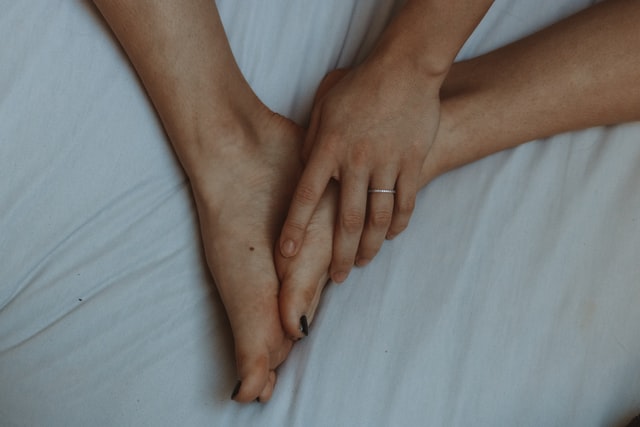
Other Forms of Heel Pain
Plantar fasciitis and chronic heel pain syndrome are the more common causes of heel pain, but they are not the only causes! There are other conditions that can cause heel pain, such as tarsal tunnel (medial calcaneal nerve entrapment), calcaneal apophysitis (Sever’s disease), calcaneal fracture, Achilles tendinopathy and retrocalcaneal bursitis.
Tarsal Tunnel/Medial Calcaneal Nerve Entrapment
Tarsal tunnel can be very similar to plantar fasciitis, which can make it easy to confuse the two. This difference with this condition, is that the pain is nerve related. Nerve pain feels more like burning, tingling and/or numbness.
What is Tarsal Tunnel?
The tarsal tunnel is the area on the inside of the ankle, and the pain develops when the neve running though here becomes irritated (the medial calcaneal nerve). Pain from tarsal tunnel can develop on the inside of the ankle, on the heel, or even under the entire foot.
Causes
Tarsal tunnel pain can develop due to excessive arch collapse, an ankle injury, arthritis or diabetes.
Excessive arch collapse and collapse at the heel can lead to tarsal tunnel because it puts strain on the structures on the inside of the ankle. Tarsal tunnel is a rarer condition than something like plantar fasciitis, therefore, not every person with an arch collapse will develop it.
An ankle injury or trauma to the area can also irritate the structures in and around the tarsal tunnel. An injury could pull the structures on the inside of the ankle, or a direct hit to the area can cause irritation.
Arthritis and diabetes can lead to tarsal tunnel due to swelling that can occur in the area. Increased swelling reduces the space in the area, which can contribute to irritation of the nerve in the tarsal tunnel.
Calcaneal Fracture
A calcaneal fracture also causes heel pain, but it is typically diagnosed relatively quickly. This is because a fracture is trauma related and you can typically pin point exactly when the injury occurred.
What is a Calcaneal Fracture?
A calcaneal fracture is when the heel bone (calcaneus) has been broken. This is very similar to a broken arm or leg, but it is the heel bone in the foot.
Causes
The cause of a calcaneal fracture is a direct trauma to the heel. It typically takes a very large force to cause this fracture, such as a fall from a large height.
Calcaneal Apophysitis (Sever’s Disease)
Sever’s disease is another cause of heel pain but occurs only in children. It is most common in boys aged 7-15.
What is Sever’s Disease?
Sever’s disease is an irritation at the growth plate at the back of the heel. Pain develops at this area on the back of the heel, where the Achilles tendon attaches to the bone. Because this pain is associated to the growth plates, the pain will resolve once the growth plates have closed.
Causes
Excessive arch collapse, heel collapse and tight calves can all contribute to the development of Sever’s disease. All these factors will increase the pull to the growth plate from the Achilles tendon.
Achilles Tendinopathy
Achilles tendinopathy is another condition that leads to pain at the back of the heel due to irritation at the Achilles tendon or attachment point.
What is Achilles Tendinopathy?
This is a general term used to describe pain and swelling at the Achilles tendon. It can be irritation to the actual Achilles tendon, or it can be irritation to the attachment point of the Achilles tendon. Pain can occur by touching the area, stretching the calves, or during activity.
Causes
Like Sever’s disease, tight calves and a collapsed heel can cause Achilles tendinopathy by causing excessive strain to the Achilles tendon. Heels that roll outwards can also cause Achilles tendinopathy, because it pulls the Achilles tendon in the opposite direction.
Retrocalcaneal Bursitis
Retrocalcaneal bursitis may seem similar to Achilles tendinopathy, but it is a different structure and slightly different pain area.
What is Retrocalcaneal Bursitis?
Retrocalcaneal bursitis is an irritation of the structure behind the Achilles tendon, called the bursa. This bursa is a pocket filled with fluid to protect irritation between the Achilles tendon and the bone. When this bursa becomes irritated, it leads to pain associated with retrocalcaneal bursitis. Pain can be felt behind the Achilles tendon and is more painful when pinched.
Causes
Like Achilles tendinopathy, tight calves, a collapsed heel (pronation) and a heel that rolls outwards (supination) can all lead to retrocalcaneal bursitis. These all put excessive strain on the Achilles tendon, which can rub and irritate the bursa. Excessive exercise or activities that bend the ankle consistently can also lead to retrocalcaneal bursitis.
Treatments
Orthotics
When the feet are causing or contributing to heel pain, custom orthotics and generic inserts are a great way to treat the pain. They help to control the foot motions to prevent the stress and strain leading to heel pain.
With cases such as Sever’s disease and trauma related pain, orthotics can be a temporary solution until the area has been healed. There are specific cases when orthotic wear may need to be continued long after the healing is done. This is a case by case basis!
Footwear
The proper shoes can also make a positive impact on heel pain, especially when complimenting an orthotic device. Make sure they have the appropriate support and fit for the feet! There are styles that have extra support on the inside of the shoe for flat feet, but these are not suitable for a high arch. In general, make sure the shoe doesn’t bend easily though the middle and at the heel.
For more information, please contact us or book an appointment!

You must be logged in to post a comment.